Using Miniaturised Wearable Humidity Sensors to Improve COVID-19 Contact Tracing
We are used to thinking of atmospheric humidity as variable which changes on time scales of hours (or days) and long time scales. Here is for example the current atmospheric humidity in the UK at the time of writing this:
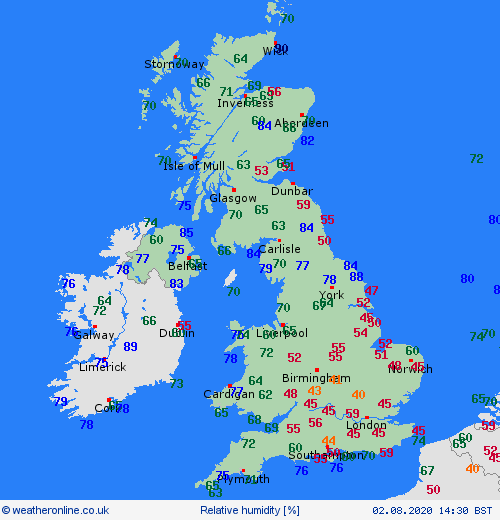
(The map is from this https://www.weatheronline.co.uk/weather/maps/current?LANG=en&CONT=ukuk&LAND=UK®ION=&SORT=2&UD=0&INT=06&TYP=feuchte&ART=karte&RUBRIK=akt&DATE=–&CEL=C&SI=mph site).
As you can see humidity is close in value over distances sometimes 100s kilometres apart and if you follow the map you will see humidity evolving slowly over the course of the day.
Humidity also varies strongly on short distances and timescales
It is therefore at first surprising that relative humidity varies strongly on short distances (down to ~10s centimetres) and timescales (down to ~10seconds).
The underlying physics is simply that water can co-exist in all three phases of matter on Earth’s surface and in the atmosphere. In the gas phase it is measured as relative humidity which only slowly equalises via typically turbulent mixing of air. The liquid phase (i.e., liquid water) however provides a reservoir from which local relative humidity can rapidly be increased. The liquid phase varies over largest scales (oceans), localised scales (rivers, streams, puddles) down to walking and talking scale (the human beings!). To understand significance of a human recall that the human lung has a surface of about 50 square metres, much bigger than typical puddles of water in urban environment!
Human breath is saturated with water vapour (about 0.03ml per breath) which is often the main source of water vapour in indoor environments. As a source, it is very localised (i.e., our mouth) and time variable on timescales of seconds (changes in positions of humans, as well as in pattern of exhaling due to e.g., speech or exertion).
We can measure the micro-structure of relative humidity extremely well
Up until quite recently the most common way of measuring relative humidity of air was be measuring how much human (or horse) hair tries to curl up in it. This measurement is surprisingly accurate (to maybe 3 or 5%) but not very precise and has a slow time constant.
Now we have Micro Electro-Mechanical Systems (MEMS) which measure relative humidity. They are widely used in unexciting applications such tumble-driers and air-conditioning systems. But their capabilities far surpass such simple applications:
They are extremely small
MEMS humidity sensors are much smaller then the tip of a pencil. The sensor is the small metal covered chip in the image below:
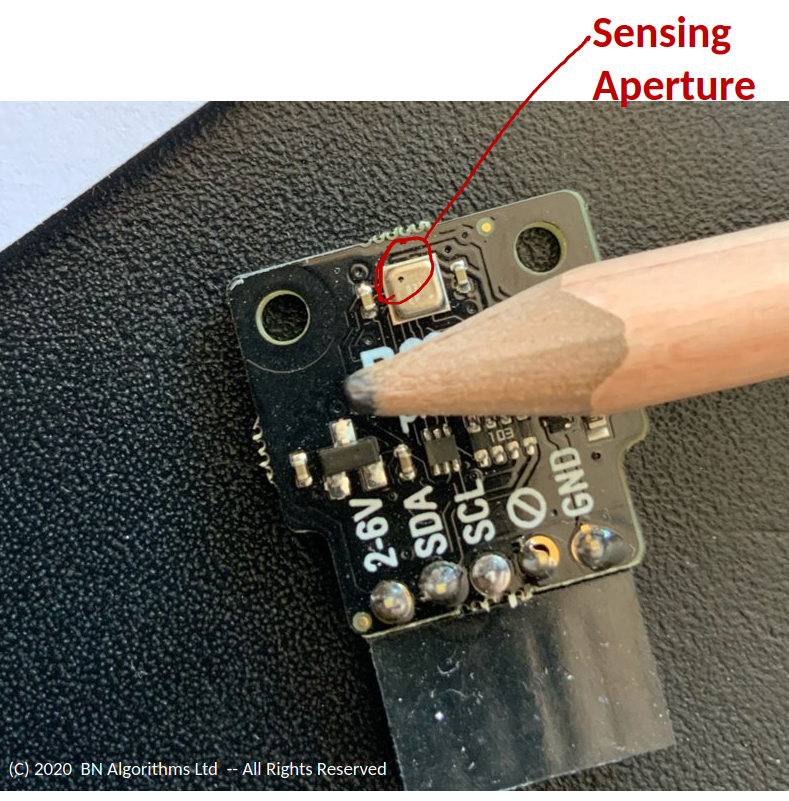
They have very high relative accuracy
Their absolute accuracy is still only around 2%, but their relative accuracy and precision are far, far better: down to 0.01%.
They are fast
Their time constant (probably driven by their miniature size) is as short as 10 seconds
Together this means we can measure the humidity microstructure indoors incredibly accurately. Below is measurement from two MEMS sensors about 10cm apart on my desk in my home office without any disturbance around them:
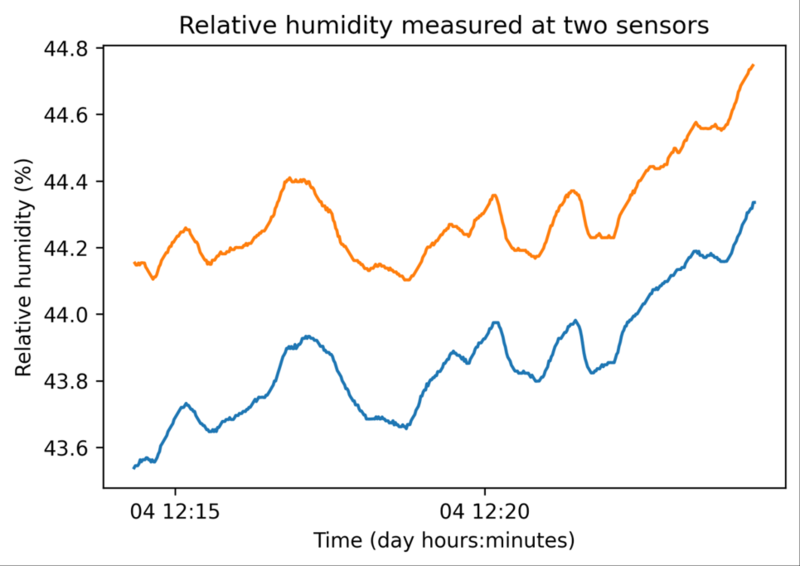
In these measurement we can see:
-
We are measuring variations of humidity on time scales of 10s of seconds
-
The correspondence between the two sensors is very close, showing these variations are real and correlated in space
-
The noise in measurement is very low, far lower then the real humidity variations even in this quiescent experiment
How much do humans contribute to the humidity microstructure? Below is a measurement with similar setup but with me blowing a single moderate breath in the direction of the sensors from about 70cm away:
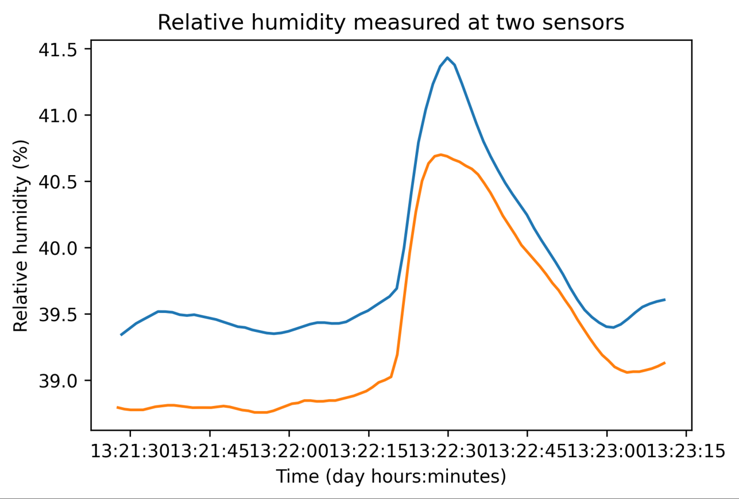
We can see an increase in relative humidity of about 1.5%, far greater than the quiescent fluctuations.
How can we use this for COVID-19 contact tracing?
The dominant transmission mechanism of COVID-19 virus appears to be very small droplets or aerosol exhaled by the infectious person and advected by air through to mucous membranes of the contact. For the virus to be carried to the contact, there needs be mixing of air between the infectious person and the contact – a barrier such as a thin window will completely stop the mixing of air and also any possibility of virus transmission.
By measuring fluctuations of relative humidity we can estimate if the air is mixed between two points. Furthermore since we know the fluctuations are strongly influenced by human exhalation, and that the virus is introduced in the same way into the air, we know similar fluctuations in relative humidity, on the right time scales, are likely due to mixing of exhaled breaths of the infectious persons and the contact.
As an illustration here is a recording of relative humidity measurements by sensors worn by two people engaged in conversation at a distance of around 1.5 metres:
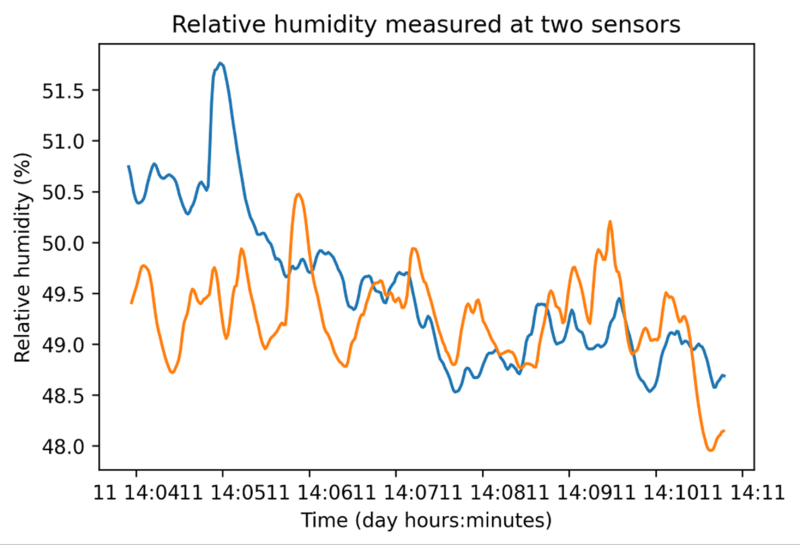
What can be signs are sign of correlation of fluctuation in relative humidity. This is a tell-tale sign that the air is mixed between the two contacts and that therefore there is a possibility of the transmission of COVID-19 if one of the people was infectious at the time of the conversation.
In combination with standard Bluetooth based contact tracing technologies, such measurements can significantly improve the accuracy of estimation of COVID-19 transmission risk and help us all get back to doing more of the things we find enjoyable and useful.
Putting this into practice
We working on developing this technology further and putting into practice.
We provide following services:
-
Consultancy on design and testing of integrated sensing systems
-
Licensing of software to acquire data both from sensors and Bluetooth modules
-
Licensing of software for data analysis to estimate transmission risk
Our aim is for this technology to be available wherever it will be useful. You can contact us at info@atmofencing.com .
